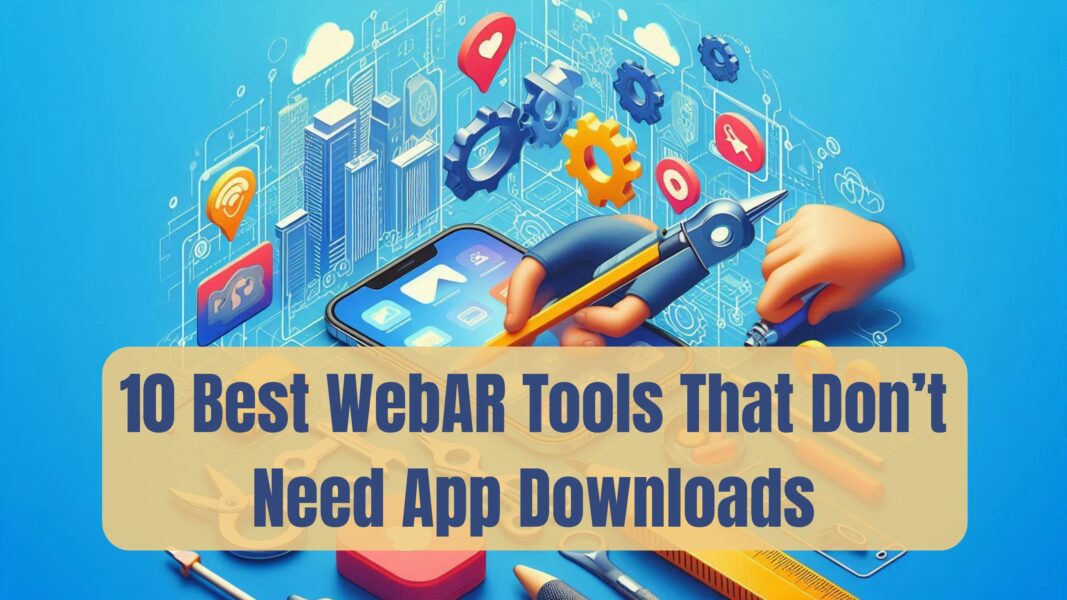This TechyNerd article explores the top 10 WebAR tools available in 2025 that allow developers, designers, and businesses to create immersive AR experiences directly within web browsers—without requiring users to download any app. With rising demand for frictionless augmented reality, these tools are ideal for e-commerce, marketing, education, gaming, and virtual product experiences. Whether you’re a beginner or an experienced developer, this guide presents the most capable platforms based on ease of use, features, support, and deployment flexibility.

What are WebAR tools?
WebAR tools enable users to experience augmented reality content directly through a mobile or desktop web browser. Unlike traditional AR platforms that require users to download native apps, WebAR tools reduce friction and boost engagement by offering instant access to AR experiences.
Why is WebAR important in 2025?
With increased mobile usage, 5G networks, and better browser-based 3D rendering, WebAR is becoming a top choice for marketers, educators, and developers. These tools empower creators to publish AR content faster and make it accessible across devices with a single link.
Top 10 WebAR Tools in 2025 That Require No App Downloads
1. 8thWall
- Overview: A leading WebAR development platform acquired by Niantic, 8thWall allows creators to deploy immersive AR directly through the browser.
- Key Features:
- World tracking and image target support
- Cloud editor and WebAR hosting
- Face effects and light estimation
- Best For: Brands and agencies looking for enterprise-grade AR campaigns
- Pros: Rich documentation, wide device compatibility
- Cons: Premium pricing
2. Zappar (ZapWorks WebAR)
- Overview: Zappar’s WebAR toolkit allows users to deliver content-rich AR experiences via browser using its own CMS and tools.
- Key Features:
- Face, world, and image tracking
- Drag-and-drop editor
- Supports instant deployment
- Best For: Marketing and educational content
- Pros: No-code editor available
- Cons: Free version has branding
Also Read: 10 Best Free Tools for Building AR Apps: 2025 Guide for Developers & Creators
3. 8XR
- Overview: A no-code WebAR creation platform with interactive design features for business and education sectors.
- Key Features:
- Image tracking, spatial placement
- Real-time analytics
- Cross-browser performance
- Best For: Designers and educators
- Pros: No technical skills needed
- Cons: Limited advanced development options
4. WebAR Studio by Rock Paper Reality
- Overview: A WebAR creation suite backed by a team with deep industry experience, offering services and a no-code builder.
- Key Features:
- World-anchored content
- Web hosting integration
- Enterprise deployment options
- Best For: Retail, automotive, and exhibitions
- Pros: High-quality visual fidelity
- Cons: Service-based model
5. 8i
- Overview: Specializes in volumetric video and immersive holographic WebAR content through web links.
- Key Features:
- Realistic 3D humans in AR
- Cloud-hosted experiences
- Web-based playback
- Best For: Media, sports, and entertainment
- Pros: Unique 3D capture quality
- Cons: Less customization for general AR scenes
Also Read: AI Tools for Automating Social Media Marketing: A 2025 Guide
6. Aryzon WebXR Tools
- Overview: Aryzon offers WebXR-compatible tools that support depth sensing and 3D interaction in browsers.
- Key Features:
- Works with mobile WebXR APIs
- Depth-aware placement
- Cardboard and AR headset compatibility
- Best For: Tech-savvy teams and engineers
- Pros: Open development approach
- Cons: Some advanced features browser-dependent
7. Banuba WebAR SDK
- Overview: A lightweight WebAR solution focused on face filters and virtual try-ons for e-commerce and beauty.
- Key Features:
- AI-driven face tracking
- Glasses and makeup try-on
- Works in mobile Safari and Chrome
- Best For: Fashion, beauty, and social media
- Pros: Fast performance, cross-platform
- Cons: Specialized use cases
8. PlayCanvas + WebXR
- Overview: A full 3D game engine that supports WebXR, ideal for custom WebAR applications with real-time graphics.
- Key Features:
- Real-time collaboration in the editor
- WebGL rendering and WebXR integration
- Supports physics and animations
- Best For: Developers and 3D game creators
- Pros: Full control, real-time updates
- Cons: Requires development experience
9. MindAR.js
- Overview: A lightweight open-source WebAR library for building image and face tracking apps.
- Key Features:
- Fully browser-based
- No cloud services required
- Easy to embed on websites
- Best For: Indie developers and small teams
- Pros: Free, community-supported
- Cons: Requires manual coding
Also Read: The Debate Over AI Art: Originality, Soul, and Cultural Impact
10. BlippAR WebAR SDK
- Overview: BlippAR provides a complete SDK for creating WebAR scenes, often used in product visualization and branding.
- Key Features:
- Supports AR product displays
- No app download, works with QR codes
- Cloud deployment
- Best For: Retail and brand marketing
- Pros: Feature-rich, robust analytics
- Cons: Mid-range learning curve
Choosing the Right WebAR Tool
When selecting a WebAR tool, consider these factors:
- Ease of Use: No-code platforms like 8XR and ZapWorks are best for marketers and designers.
- Feature Requirements: Tools like 8thWall and PlayCanvas offer deep control for custom development.
- Deployment Needs: If rapid publishing and QR code integration matter, BlippAR and Zappar are solid picks.
- Budget: MindAR.js offers an open-source entry point, while premium options include enterprise-level support.
WebAR Use Cases in 2025
- E-Commerce: Try-before-you-buy with products rendered in the user’s environment.
- Education: Interactive models for anatomy, astronomy, or historical walkthroughs.
- Marketing: Launch campaigns instantly using QR codes or short URLs.
- Gaming: Browser-based AR games with spatial interaction and leaderboards.
- Real Estate: Property visualizations without requiring physical visits or apps.
Also Read: Chinese AI Farming Bot Kwoo Wins Global Innovation Award
Final Thoughts
WebAR is redefining how users interact with digital experiences by eliminating the app barrier. Whether you’re building educational content, launching a product campaign, or developing interactive brand filters, these tools make it possible to do more—with less friction. In 2025, adopting WebAR tools is no longer optional; it’s a competitive advantage.

